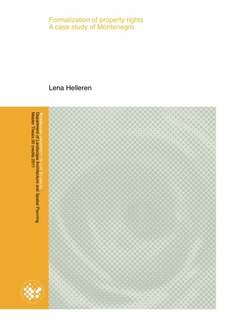| dc.contributor.author | Helleren, Lena | |
| dc.date.accessioned | 2011-11-11T08:56:24Z | |
| dc.date.available | 2011-11-11T08:56:24Z | |
| dc.date.copyright | 2011 | |
| dc.date.issued | 2011-11-11 | |
| dc.identifier.uri | http://hdl.handle.net/11250/188258 | |
| dc.description.abstract | Informal and illegal construction has been a part of Montenegro’s development since the 1990s. It is estimated that there are around 100 000 informal/illegal constructions in Montenegro, which is approximately 1/3 of the total housing stock in the country (Onsrud 2010). Illegal and informal construction is common on the whole territory of the country and often in concentrated living areas, thus creating a whole informal settlement.
A typical feature of such construction is either absence of a licence for construction, or construction differing from the conditions of the licence. Most commonly the illegal/informal construction occurs on the investor’s private land, but such construction also occurs on the municipal land. The informal/illegal construction has a negative effect on the country’s development.
There are various reasons for the increase of illegal construction in the country. One of such reasons is insufficient land administration during the past two decades. The procedures for obtaining a building permit and registration of property are awfully long, time consuming and costly. The system is so complicated that even the local authorities have difficulties understanding all of the procedures. The local authorities are imposed to double-check and even triple-check all the necessary documentation submitted by the investors for obtaining a building permit, which makes the system very little productive and costly.
Amongst other reasons for illegal/informal construction are migration, rapid urbanization, establishment of a free market economy in the country and corruption. The lack of sufficient legislation on illegal/informal structures also contributed to the investors’ fearless attitude towards the illegal/informal construction.
The main goal of this study is to describe the existing situation and to contribute to the theoretical understanding of the possible reasons for which illegal/informal construction occurs. This thesis includes the discussion of different aspects that are connected to the problem of informal settlements such as property rights, land administration, public regulations, development and negative impact on the environment. This thesis is based on the knowledge gained through the study of available literature about the theme and a fieldwork in the country of concern. | no_NO |
| dc.language.iso | eng | no_NO |
| dc.publisher | Norwegian University of Life Sciences, Ås | |
| dc.subject | Formalization of property rights | no_NO |
| dc.subject | Regularization | no_NO |
| dc.subject | Land tenure | no_NO |
| dc.subject | Land administration | no_NO |
| dc.subject | Illegal construction | no_NO |
| dc.subject | Tenure security | no_NO |
| dc.subject | Montenegro | no_NO |
| dc.subject | Informal development | no_NO |
| dc.title | Formalization of property rights: a case study of Montenegro | no_NO |
| dc.type | Master thesis | no_NO |
| dc.subject.nsi | VDP::Social science: 200::Urbanism and physical planning: 230::Building and regulation planning: 234 | no_NO |
| dc.subject.nsi | VDP::Social science: 200::Urbanism and physical planning: 230::Spatial, territorial planning: 238 | no_NO |
| dc.source.pagenumber | 124 | no_NO |
